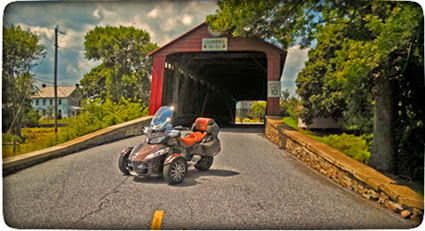|
-
Active Member

 What tire pressure? What tire pressure?
I just put on a new Kumho Ecsta AST 225/50R15 on my 2015 RTL. The OEM only got 11160 miles. Pretty disappointing. I ran the suggested pressure from the owners manual at 28 lbs. It wore out a 3 " strip right in the middle of the tire. My question to the learned members of this forum is what pressure would you recommend for my new tire. I am 250 lbs, we are 2 up sometimes, she is 150 lbs but I ride alone quite a bit. Since this is a "car tire" I am not sure how stiff it should be.
Thanks
Mike Campbell
Amarillo, Texas
2015 RTL "intense red pearl"
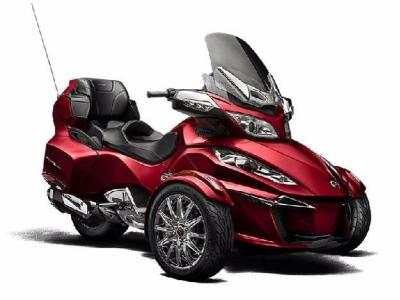
-
Very Active Member
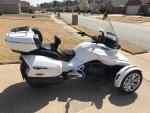

I would run 28 and expect about 18,000 out of it, at least that is what mine does, this is a 4 ply not a 2 ply like the OEM
Cruzr Joe
2018 F3 Limited, BRP Driver Backrest, Spyderpops Lighted Bump Skid, Dual Spyclops Light, Mirror Turn Signals, Laser Alignment, Engine LEDs, Fog Lights With Halo's, Cushion Handgrips, BRT LEDs, and Under Lighting, Lamonster IPS, (with Clock), F4 25" Vented Windshield with Wings, Airhawk "R" Cushions. Position 4 Brake setting, Short reach Handlebars, Dash Mounted Voltmeter and 12 Volt Plug. Set of 3rd pegs. Extended Passenger Seat. Exterior BRP Connect setup, Ultimate Trailer
-
Very Active Member
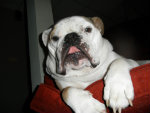
 TIRE PRESSURE TIRE PRESSURE
I have many many posts concerning this question with long detailed reasons WHY ..... they are on file .... But the answer in the end is 21 psi ...COLD for any car tire on the rear of the RT..... or you can go with another members S.W.A.G. ........ take your pick .........Mike 
-
Very Active Member
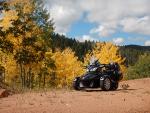
 Hi Mike.. Wife runs 24 psi at 70 F on her 15 RTS. Hi Mike.. Wife runs 24 psi at 70 F on her 15 RTS.
Just got back from a weekend run to Red River, 2 up for a change on her bike. I weigh 215 and was on back most of the way. Good ride and trip. She has almost 30,000 miles on her Kumho Ecsta AST mostly one up, but it is wearing even with still 3-4 mm of tread out of 9 to start with. I just put a Kumho on after wearing the OEM Kenda out at 13,500 miles. I run 25 psi on the rear for my extra weight. I would think that 24-26 would be good for you if 2 up most of the time and based on your mileage on the Kenda. Your call, your ride. DSCN1590.jpg PS.. we lived out on Soncy for 10 years and wife said it was her favorite house.
-

Mike153, FYI the Kenda will wear out in the middle, like yours did, regardless of the tire pressure you run.
2017 F3T-SM6 Squared Away Mirror Wedgies & Alignment
2014 RTS-SM6 123,600 miles Sold 11/2017
2014 RTL-SE6 8,600 miles
2011 RTS-SM5 5,000 miles
2013 RTS-SM5 burned up with 13,200 miles in 13 weeks
2010 RTS-SM5 59,148 miles
2010 RT- 622
-
-
Very Active Member


Car tires due to extra plys run flatter across the width of the tire. In other words, they do not balloon with speed like the Kenda.
I only got 11,500 out of my Kumho... But it was worn evenly across the tire and I kept the PSI at 30-32. Same was true on the Toyo's I've run.
You have to remember that also due to the extra plys, the car tires actually are rating for more weight. Think about it. Your RT is 1300-1500 Pounds fully loaded with you, passenger and gear. Average car tire supports 1700 pound of weight and your spyder is weight biased towards the front.
I would strongly recommend not running them too low of a PSI as you still want to avoid sidewall flex which creates heat. Probably still worse to do that on our cars, but again, I kept mine at 30-32 and they wore even and rode nice.
Car tires on the front are different however. I ran my Bridgestone RE-92's at 22PSI as any harder and they tended to push out under hard riding... Still even wear at that pressure and given there was two of them holding up the front of the spyder I wasn't too concerned at that low a pressure.
WackyDan - Fun, not crazy.
Charlotte (Matthews), NC
Silver Moon SM5 - V35 and V46 Givis, CHAD, Motolight 35w steering lights, Dash Powerlets, Helibar risers, Garage door opener, Eastern Beaver PC-8, Digital voltmeter, Kewl Metal Intake, Evoluzione Sway Bar, RT Shocks and Juice Box PRO.
*Mower deck in development*
2008 model -new in crate, April 09
26,000 miles.
Looking for other Charlotte area riders to cruise with and compare Spyders.
HAPPY SPYDER OWNER
-
Ozzie Ozzie Ozzie
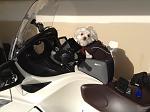

The various car tire manufacturers will have published details of what pressure their tires need to carry a given load - and you REALLY DO WANT your tire sidewalls to flex a little & heat up the tread compound to its operating temp or that tire will not only wear faster in the middle of the tread but it will have less grip/traction too, especially on damp or wet roads!! (Which means a major hydro-planing risk for the Spyder rear tire!!) So for most more robustly constructed car type tires, the necessary pressure for a Spyder sized load is going to be a fair bit lower than the 28 psi or so the lightweight OE Kenda calls for!! I run a 225/60R15 Kumho KH17 on the rear of my 2013 RT, (so its a little bigger than stock & will need a little less air because of that too) & for the weight of my Spyder while riding solo, Kumho specifies an inflation pressure of 16psi - add the extra weight when carrying my wife pillion, that specified necessary pressure goes up to 18psi!! Running those pressures, my Kumho's have done over 25,000 miles so far! 
Many people make the mistake of running their car tires under a (relatively) light weight Spyder a fair bit higher than is strictly needed by the tire carrying that load - I'd be very surprised if a car tire in a Spyder fitting size that was originally designed to carry the load of about 1/4 of a car would need much more than about mid 20's psi air pressure in it to carry the about 1/3 of a Spyder load it'd be carrying when fitted under a Spyder, but you can track down the detailed pressure vs load table published by most tire manufacturers & look up what's needed to carry the weight of your loaded Spyder - your local garden centre or wood lot will probably be able to help weigh the load on the front & rear of your Spyder. Inflate them too much & you might get some pretty direct steering on a dry road, but the ride will be harsher than it needs to be, the tire will never warm up to its optimum operating temp so traction will be less than ideal & hydro-planing on damp/wet roads a real risk, and it will be transferring a lot of extra 'wear' into the suspension than it should, simply because the tire wont flex enough to absorb any of the road bumps or pit hole hirs etc. This also exposes the tire to a greater puncture risk too, because the too tight tire wont be able to flex around/over any road debris or pot hole edges - try blowing up a balloon just a little then poking it with your finger to burst it; not easy when it's soft & flexy, but if you blow it up hard, see how easy it is then!! Over inflation of a car tire under the relatively light load of a Spyder is generally more risky than a pound or two of under inflation - that said, you probably don't want to go much lower than 12-15psi anyway, especially on the rear, or you'll run the risk of peeling the bead off the rim while accelerating hard or cornering. 
Last edited by Peter Aawen; 10-24-2016 at 01:45 AM.
-
Ozzie Ozzie Ozzie


If you want a rough guide to what the 'proper' table from the manufacturer will contain, look for the Max Load xx lbs @ Max Pressure yy psi that your tire will have printed on the sidewall (well, they do/must have that info in Aust anyway!!  ) It's going to say something like this: ) It's going to say something like this:
Max Load 1550 lbs at Max pressure 38 psi
That's all OK, but the loaded rear tire of my Spyder usually only weighs in at about 515-520 lbs with me & my 'normal' solo load aboard, so how do I work out what pressures I need for MY Spyder & its normal load?? You hafta do a bit of calculating to scale the Max loads & Pressures down to the loads you are usually putting on your Spyder, & your calculation might be a little different to mine simply because you load your Spyder differently & you may weigh something different to what I weigh! So MY 'rough calculation' to work out the necessary 'cold start' tire pressure goes something like this:
The Max Load if 1550 lbs divided by my actual load of 515 lbs = 3.009 or by 520 lbs = 2.98; therefore I need to divide the Max Pressure of 38psi by 'about' 3 which comes to about 12.6-12.8 psi for the static load on my rear tire - but you need to add 4 psi to allow for the extra stresses of 'driving' over that of static loads & that gives me a rough guide for the necessary 'cold start' pressure of 16-17psi solo - and when I tracked down the actual table from Kumho it worked out to be pretty damn close to that, specifying 16psi for 520 lbs. I did the same rough calc for the weight of my fully loaded & rider plus pillion carrying rear tire, that calc worked out at 17.5-18psi & the Kumho chart said 18psi to carry 540 lbs.... The front tires (I run 175/60R15 Kumho KH17's) worked out at 16psi solo & pillion (no measurable difference between solo or pillion weights on the weigh bridge I used) & the Kumho chart said 16psi....
So as recommended by the tire manufacturer in their weight/pressure table and by the rough calculation done using the weight/pressure info printed on the sidewall of the tires, I run 16 psi up front in my slightly larger than stock sized Kumho tires for both 1 or 2 up; and 16 psi in the slightly larger than stock sized rear tire solo, 18psi in the rear when running loaded & 2 up. 
With the sort of riding I do, I'd expect a 'closer to OE Spec sized' car tire to need slightly higher cold start pressures to carry similar loads; a bit more pressure again to carry greater loads than those I usually carry; and about the same or possibly a touch less pressure to carry lighter loads. Those 'cold start' pressures should be adjusted up or down a little to cater for different ambient &/or road surface temperatures (colder climates might need a couple of psi less to help them get warm enough for proper traction on cold roads; while hotter climes may need a couple of psi more in them to stop them over-heating on hot roads!) & maybe for more or less spirited riding, but they are a pretty good start & the 4psi Rule will let you fine tune them to the optimum for your Spyder tires carrying your Spyder loads. 
NB: the recommended pressure for a Kumho KH16 or any other size or brand of tire may well be different to that outlined above, so don't just use the figures & calcs above as verbatim for you/your tires unless EVERYTHING is exactly the same; ie size, tire brand, tire type, loads, where you ride, etc - they are provided here as an example of how to derive them & do the rough calcs & are really only applicable to me/my tires, loads, & circumstances; & my 'guesstimations' of what other tires may need are just that, given the assumptions outlined & some guesses about the expected loads on Spyders; ie, they are guesses & estimations provided to help you grasp the concepts discussed. YMMV.
Last edited by Peter Aawen; 10-24-2016 at 07:36 AM.
-

I run 24 psi in my Kumho. It's got 10,500 miles on it now, and still has another half-season's worth of life in it.
Peter and Mike keep telling me that I could drop it down a couple of psi lower... I probably could, but am just ruminating over that action for right now...
-
Ozzie Ozzie Ozzie


And it's fair enough if you decide that you don't want to drop another couple of psi out for whatever reason, Bob, after all, it is YOUR Spyder & it is YOU ryding it - but making that decision based upon a reasonably educated awareness of what the risks &/or benefits might be is much better than just having a wild stab in the dark or slavishly sticking to a placard that refers to another tire brand & type anyway!! 
Last edited by Peter Aawen; 10-24-2016 at 07:37 AM.
-
-
Active Member

 Good info but..... Good info but.....
I will probably drop it down to about 24 psi but it looks flat at those pressures! But then it is a car tire on a non leaning roadster motorcycle which will take some getting used to.
Mike Campbell
Amarillo, Texas
2015 RTL "intense red pearl"

-
Very Active Member
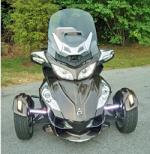

FWIW, I agree with Mike and Peter and others who say that the "recommended" 28 psi is way too much for an automotive tire which has a much stronger sidewall than the OEM Kendra. I've been running my Yokohama at 24 psi, and have just reduced it to 22 psi to see how that does. (When I first had the Yoko installed by Netzley Tire (who do a huge amount of Spyder work), they recommended 20 psi for my new Yoko s-Drive.)
Last edited by robmorg; 10-24-2016 at 06:28 PM.
-
Very Active Member

 HOLY CRAMOLY HOLY CRAMOLY
Last edited by BLUEKNIGHT911; 10-24-2016 at 10:59 PM.
-
Ozzie Ozzie Ozzie


 Originally Posted by Mikel53

I will probably drop it down to about 24 psi but it looks flat at those pressures! But then it is a car tire on a non leaning roadster motorcycle which will take some getting used to.
That's why you should NEVER use 'sight' to guess at 'correct' or even 'OK' for your tire pressures Mikel53 - almost invariably 'looking at them' & pumping them up until they 'look right' will get the pressure wrong! 
Going from one tire to the next or even one inflation to the next & 'looking' for what looks right can give you a vastly different pressure from one to the next despite them both 'looking' the same, & especially with radial tires, the sidewalls actually need to bulge somewhat & 'look sorta flat' (even more so with 60 or lower profile tires!) in order to have pressure in them that allows the sidewall to flex enough in order to keep the tread contact patch relatively flat on the road surface as you drive & corner etc. As you said, do remember that it is on a non-leaning Roadster & the tire needs to be able to flex & deform to do all this! If you pump them up until they don't bulge or look sorta flat, then unlike on a leaning motorcycle tire, the contact patch will reduce significantly during cornering as the tread gets lifted off the road surface due to the tire being too tight to allow the necessary flex!! Remember that bit about how hard it is to puncture a partially inflated balloon vs a blown up tight balloon?! The less tight ballon will also flex & more of its surface area on the ground under a given load before bursting!!
So you really need to use a reliable & consistent tire pressure gauge to set pressures, & you should use the pressure stated by the tire manufacturer as that required to carry the load that you have on the tire, or at least do something like the rough calc mentioned above - or you could use the 4psi Rule, or even use the 'measure the contact patch' method (but let's not go into that here, please!!)
But whatever way you look at it, looking at a tire & going by how it looks to judge the right tire pressure IS NOT a safe way of deciding on what tire pressure to run!! (Yep, pun intended!) 
Last edited by Peter Aawen; 10-24-2016 at 07:45 PM.
-
Active Member
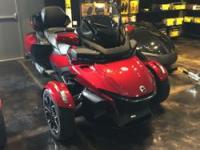
 Front tire pressure Front tire pressure
My wife and I have been riding our Spyders for 5-6 years with the front tire pressure at about 18. She went to fill hers up and correctly stated that the sidewall says a Max pressure of 30psi!!!!???? I looked and it says that on both our Spyders. My has new fronts and hers are still OEM. I got about 22000 miles on my first set, but
I don't want to run under-inflated. What's the answer?
Paul "Wingman" Metheney
2020 Can-Am Spyder RT Limited

-
Ozzie Ozzie Ozzie


WingmanRT, check your tire pressures cold (before you start riding) & then check them as soon as you stop after about an hour's riding. If the tire pressure has increased by more than about 8-10psi from your cold start pressure then your start pressures were too low & you are trending towards over-heating your tires & possibly tire failure! The ideal increase is about 4psi - less than a 4psi increase means your starting pressure was too high & you will be risking increased centre tread wear & lack of traction, especially in the wet; while an increase of more than 4psi means your starting pressure was too low & you will be risking increased shoulder tread wear, a spongy ride, & poor/sloppy handling. This phenomenon is often called 'The 4psi Rule' & it lets you as a rider/driver use it to reliably & repeatably set your pressures to suit what you want from your tires - but itire pressures are not a 'One pressure suits all' thing, for different riders, different loads, & even different road surfaces!
The Max pressure shown on the sidewall of the tire is ONLY EVER intended to be used if that tire is carrying the Maximum Load which is also shown on the sidewall of the tire!! If your tire is carrying proportionally less load, then the pressure you need to run in it needs to be proportionally less than the Max Pressure!! The vehicle itself should also have a placard with tire & pressure info on it which can be a good starting pressure if you are still running the OE tires, but please bear in mind that the pressure shown there is a 'one size fits all compromise pressure for the OE tires' that the vehicle manufacturer & sometimes tire manufacturer decides upon as a pressure that might be aimed at enhancing vehicle sales over tire longevity or traction, handling etc, or any other order there, & not necessarily at giving you the best the tire can offer in all (or sometimes any) respects - and it is definitely not catering for your individual needs/wants, use, load, or riding preferences; preferences which may entail adding a couple of psi for more direct steering in the dry at the cost of tire life & wet road grip; or dropping a couple of psi to enhance ride or traction in the wet at the slight cost of absolutely direct steering....
Most tyre manufacturers publish load/pressure charts or a load/pressure calculation formula for their tires (but few tire retailers or outlets seem to have them on hand these days, & even fewer 'tire fitters' seem to have any knowledge of them?!) so if you can find them & know the weight your tires are carrying, you can use their chart or formula to work out your ideal presure; and if you can't access/find the chart you can do your own calculations using the outline I provided in a post above & then fine tune it by adjusting up or down a little to best suit your needs/wants, or you could even use 'the 4psi rule' from the set to as a method of arriving at the pressure that will give you the optimal balance in terms of ride, handling, wear, road noise etc that you can get from your use of that tire on the roads you ride on & in the manner you ride & prefer!! Whatever you do, being aware of your tire pressures before you ride, keeping an eye on your tire pressures during your ride, & checking them regularly regardless can not only improve the performance & handling your ride provides as well as maximising the life & performance of your tires, but it can also allow you to detect potential tire issues early & save you from catastrophic tire failure, loss of traction (especially in the wet), or premature wear. Increases of much more than 8psi from your cold start pressure after an hour's riding can warn of excessive heat build-up & impending tire failure; while no increase or an increase of less than 2psi after an hours riding is an indicator of rapid 'centre of the tread' wear, poor grip, & a needlessly harsh ride!
I'm running 175/60R15 Kumhos up front at 14-16psi & a 225/60R15 Kumho on the rear also at 16-18 psi (solo & 2-up/loaded) & have so far achieved about 30,000 km of generally fairly spirited riding miles with a fair bit of high speed long distance runs on marginal roads without any issues at all. However, I'm running a comparatively heavily constructed car tire under a reasonably light & lightly loaded Spyder, so I doubt many others will ride in such a way as to warrant pressures quite that low, but that's what works for ME & my riding with the loads I carry on my Spyder! Generally, car tire pressures of around 16-18 up front & 18-22 on the rear are fine for most car tires on Spyders, altho the tire itself, the actual load on it, & your preferences can vary that up or down a few psi. The pressures that I run (which are substantially lower than the max pressure shown on the sidewall because the load on the tire is substantially less than the max load shown!) are confirmed as being 'ideal for those tires & MY usage/wants' by all three of the methods I mentioned above.... Btw, my 2013 RT Ltd Spyder only puts about 140kg/308lbs on each front tire & 220kgs/484lbs on the rear - on tires capable of carrying 462kgs/1016lbs & 710kgs/1562lbs respectively!
YMMV, & yes, the post is a bit long, sorry - but it's a good place to start if you want to get the best from your tires & your ride! 
Last edited by Peter Aawen; 03-27-2017 at 10:46 PM.
 Posting Permissions
Posting Permissions
- You may not post new threads
- You may not post replies
- You may not post attachments
- You may not edit your posts
-
Forum Rules
|





 Reply With Quote
Reply With Quote

 ) It's going to say something like this:
) It's going to say something like this: Of course... I already that!
Of course... I already that! 